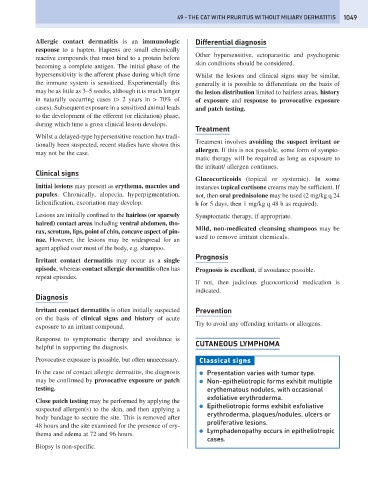Page 1057 - Problem-Based Feline Medicine
P. 1057
49 – THE CAT WITH PRURITUS WITHOUT MILIARY DERMATITIS 1049
Allergic contact dermatitis is an immunologic Differential diagnosis
response to a hapten. Haptens are small chemically
Other hypersensitive, ectoparasitic and psychogenic
reactive compounds that must bind to a protein before
skin conditions should be considered.
becoming a complete antigen. The initial phase of the
hypersensitivity is the afferent phase during which time Whilst the lesions and clinical signs may be similar,
the immune system is sensitized. Experimentally this generally it is possible to differentiate on the basis of
may be as little as 3–5 weeks, although it is much longer the lesion distribution limited to hairless areas, history
in naturally occurring cases (> 2 years in > 70% of of exposure and response to provocative exposure
cases). Subsequent exposure in a sensitized animal leads and patch testing.
to the development of the efferent (or elicitation) phase,
during which time a gross clinical lesion develops.
Treatment
Whilst a delayed-type hypersensitive reaction has tradi-
Treatment involves avoiding the suspect irritant or
tionally been suspected, recent studies have shown this
allergen. If this is not possible, some form of sympto-
may not be the case.
matic therapy will be required as long as exposure to
the irritant/ allergen continues.
Clinical signs
Glucocorticoids (topical or systemic). In some
Initial lesions may present as erythema, macules and instances topical cortisone creams may be sufficient. If
papules. Chronically, alopecia, hyperpigmentation, not, then oral prednisolone may be used (2 mg/kg q 24
lichenification, excoriation may develop. h for 5 days, then 1 mg/kg q 48 h as required).
Lesions are initially confined to the hairless (or sparsely Symptomatic therapy, if appropriate.
haired) contact areas including ventral abdomen, tho-
Mild, non-medicated cleansing shampoos may be
rax, scrotum, lips, point of chin, concave aspect of pin-
used to remove irritant chemicals.
nae. However, the lesions may be widespread for an
agent applied over most of the body, e.g. shampoo.
Prognosis
Irritant contact dermatitis may occur as a single
episode, whereas contact allergic dermatitis often has Prognosis is excellent, if avoidance possible.
repeat episodes.
If not, then judicious glucocorticoid medication is
indicated.
Diagnosis
Irritant contact dermatitis is often initially suspected Prevention
on the basis of clinical signs and history of acute
Try to avoid any offending irritants or allergens.
exposure to an irritant compound.
Response to symptomatic therapy and avoidance is
CUTANEOUS LYMPHOMA
helpful in supporting the diagnosis.
Provocative exposure is possible, but often unnecessary. Classical signs
In the case of contact allergic dermatitis, the diagnosis ● Presentation varies with tumor type.
may be confirmed by provocative exposure or patch ● Non-epitheliotropic forms exhibit multiple
testing. erythematous nodules, with occasional
exfoliative erythroderma.
Close patch testing may be performed by applying the
● Epitheliotropic forms exhibit exfoliative
suspected allergen(s) to the skin, and then applying a
erythroderma, plaques/nodules, ulcers or
body bandage to secure the site. This is removed after
proliferative lesions.
48 hours and the site examined for the presence of ery-
● Lymphadenopathy occurs in epitheliotropic
thema and edema at 72 and 96 hours.
cases.
Biopsy is non-specific.

